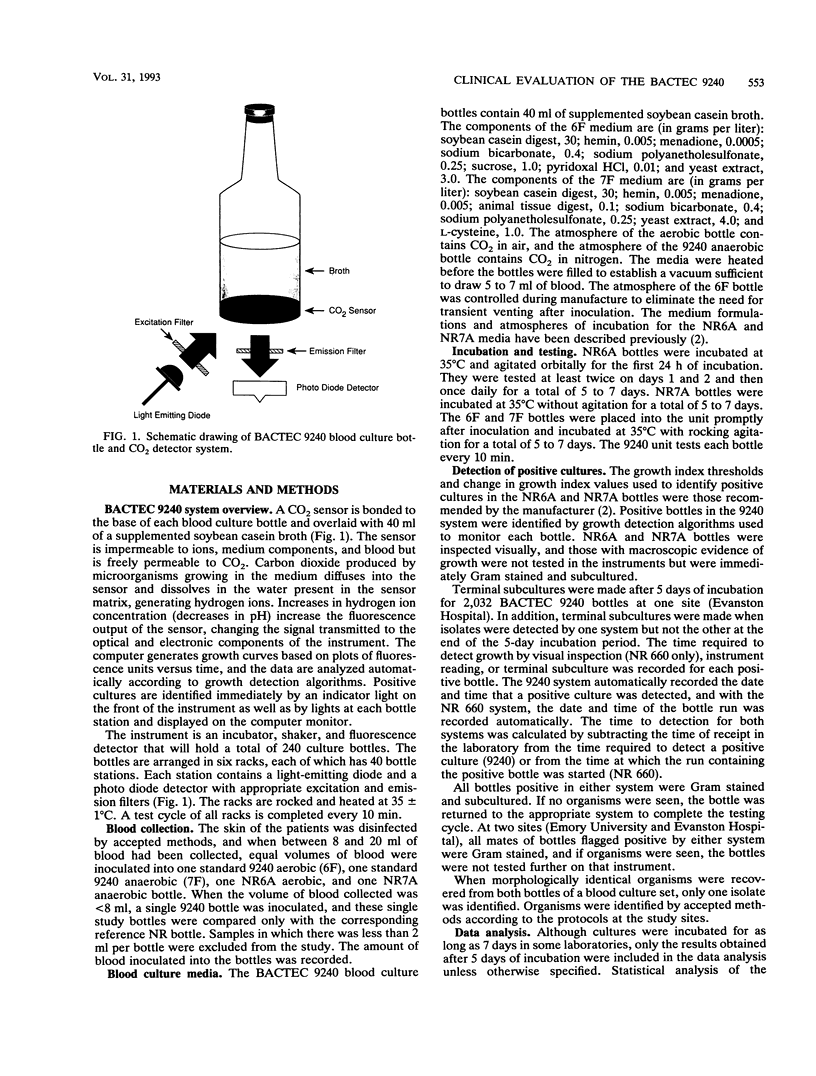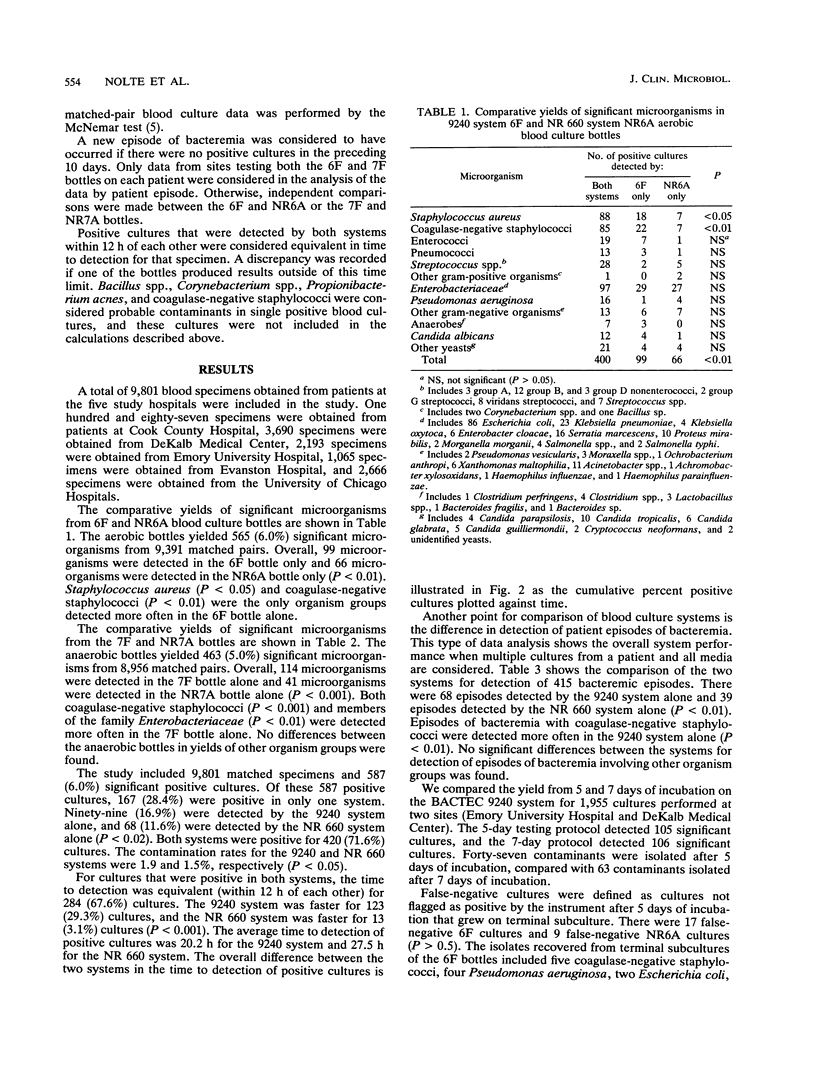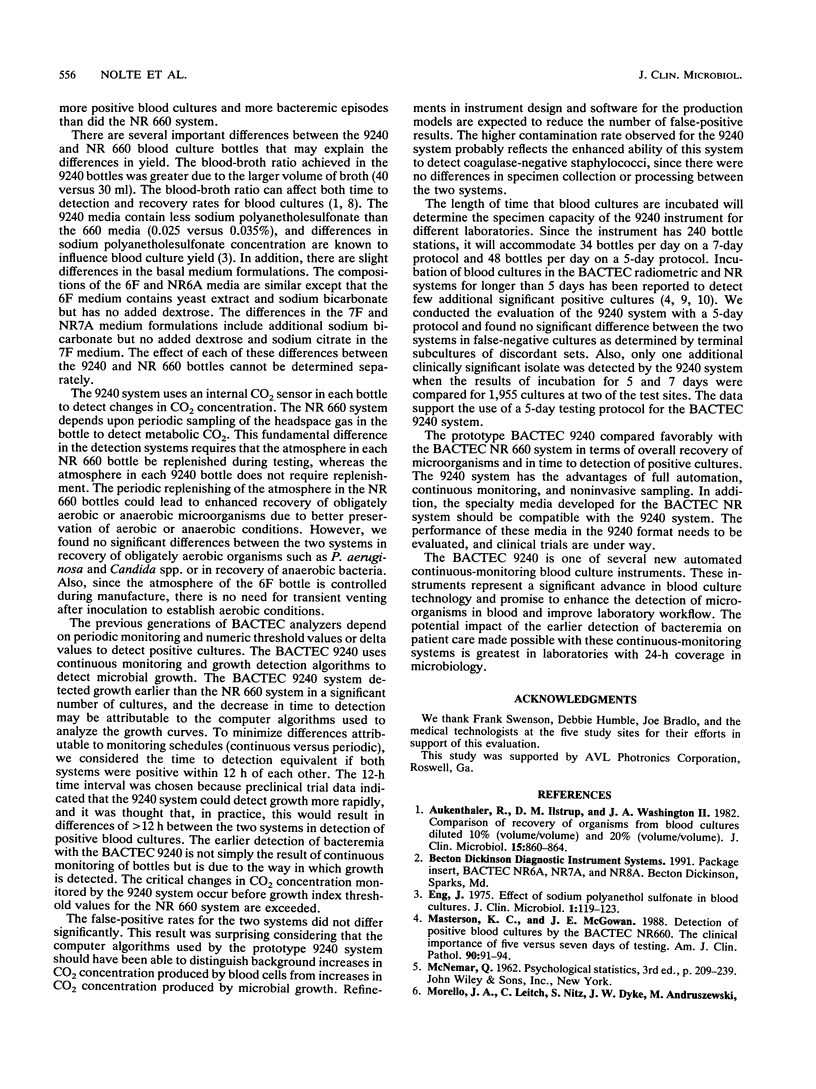Abstract
The BACTEC 9240 (Becton Dickinson Diagnostic Instrument Systems, Sparks, Md.) is a new continuous-monitoring blood culture system that uses internal, fluorescent-CO2 sensors. In a multicenter clinical trial, organism yield and times to detection with the prototype BACTEC 9240 system were compared with those of the BACTEC NR 660 system. Equal volumes of blood were inoculated into the bottles included in the study blood culture sets (aerobic and anaerobic 9240 and NR6A and NR7A bottles). A total of 9,391 aerobic and 8,951 anaerobic bottle pairs were inoculated with 9,801 blood specimens. A total of 587 clinically significant positive blood cultures and 415 cases of sepsis were studied. The standard 9240 aerobic bottle detected significantly more Staphylococcus aureus (P < 0.05), coagulase-negative staphylococci (P < 0.01), and total microorganisms (P < 0.001) than the NR6A bottle. The standard 9240 anaerobic bottle detected significantly more coagulase-negative staphylococci (P < 0.001), members of the family Enterobacteriaceae (P < 0.01), and total microorganisms (P < 0.001) than the NR7A bottle. A total of 420 positive cultures were detected in both systems; for 284, the time to detection was equivalent with both systems (within 12 h); for 123, the 9240 system was faster; and for 13, the NR 660 system was faster (P < 0.001). The average times to detection for the 9240 and the NR 660 systems were 20.2 and 27.5 h, respectively. Ninety-nine cultures were positive only in the 9240 system, and 68 cultures were positive only in the NR 660 system (P < 0.02). The 9240 system also detected significantly more episodes of bacteremia (P < 0.001). The false-positive rates for the 9240 and NR 660 systems were 2.2 and 2.3%, respectively. The false-negative rates for the two systems after 5 days of incubation did not differ significantly. The contamination rates for the 9240 and NR 660 systems were 1.9 and 1.5%, respectively (P < 0.05). In conclusion, the prototype 9240 system detected more clinically significant positive blood cultures and did so sooner than the NR 660 system, with the additional advantages of full automation, continuous monitoring, and noninvasive sampling.
Full text
PDF





Selected References
These references are in PubMed. This may not be the complete list of references from this article.
- Auckenthaler R., Ilstrup D. M., Washington J. A., 2nd Comparison of recovery of organisms from blood cultures diluted 10% (volume/volume) and 20% (volume/volume). J Clin Microbiol. 1982 May;15(5):860–864. doi: 10.1128/jcm.15.5.860-864.1982. [DOI] [PMC free article] [PubMed] [Google Scholar]
- Eng J. Effect of sodium polyanethol sulfonate in blood cultures. J Clin Microbiol. 1975 Feb;1(2):119–123. doi: 10.1128/jcm.1.2.119-123.1975. [DOI] [PMC free article] [PubMed] [Google Scholar]
- Masterson K. C., McGowan J. E., Jr Detection of positive blood cultures by the Bactec NR660. The clinical importance of five versus seven days of testing. Am J Clin Pathol. 1988 Jul;90(1):91–94. doi: 10.1093/ajcp/90.1.91. [DOI] [PubMed] [Google Scholar]
- Salventi J. F., Davies T. A., Randall E. L., Whitaker S., Waters J. R. Effect of blood dilution on recovery of organisms from clinical blood cultures in medium containing sodium polyanethol sulfonate. J Clin Microbiol. 1979 Feb;9(2):248–252. doi: 10.1128/jcm.9.2.248-252.1979. [DOI] [PMC free article] [PubMed] [Google Scholar]
- Wilson M. L., Weinstein M. P., Reimer L. G., Mirrett S., Reller L. B. Controlled comparison of the BacT/Alert and BACTEC 660/730 nonradiometric blood culture systems. J Clin Microbiol. 1992 Feb;30(2):323–329. doi: 10.1128/jcm.30.2.323-329.1992. [DOI] [PMC free article] [PubMed] [Google Scholar]


